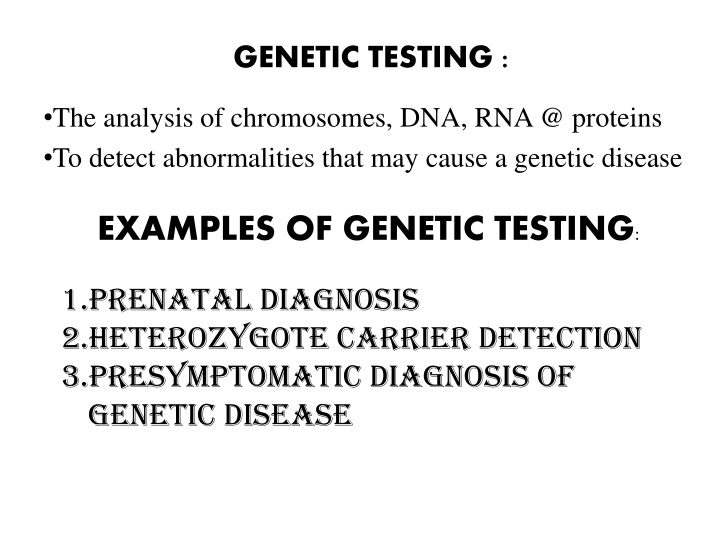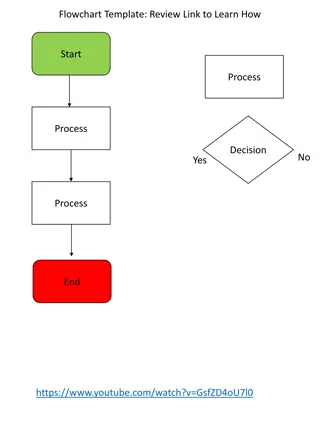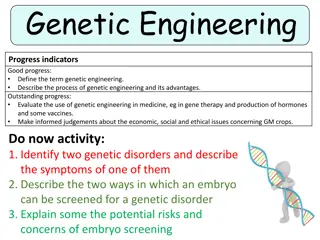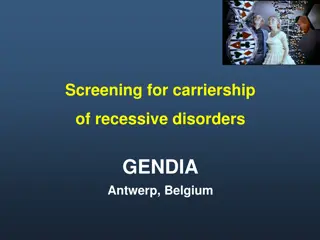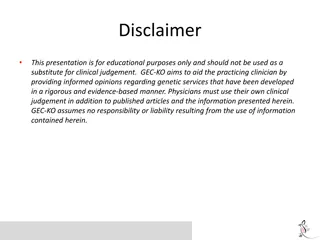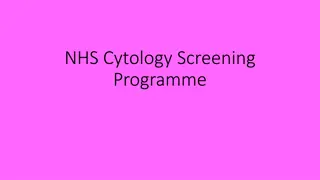Genetic Testing and Screening Overview
Analysis of chromosomes, DNA, RNA, and proteins to detect genetic abnormalities. Examples include prenatal diagnosis, carrier detection, and presymptomatic disease testing. Screening tests aim to detect treatable diseases early without providing definitive diagnoses. Principles of screening emphasize characteristics such as commonality, treatability, and accessibility of resources. Genetic screening is a rapidly advancing field used to identify faulty genes in organisms. Various types of genetic screening, like newborn screening, target early detection and treatment of genetic disorders.
Download Presentation

Please find below an Image/Link to download the presentation.
The content on the website is provided AS IS for your information and personal use only. It may not be sold, licensed, or shared on other websites without obtaining consent from the author.If you encounter any issues during the download, it is possible that the publisher has removed the file from their server.
You are allowed to download the files provided on this website for personal or commercial use, subject to the condition that they are used lawfully. All files are the property of their respective owners.
The content on the website is provided AS IS for your information and personal use only. It may not be sold, licensed, or shared on other websites without obtaining consent from the author.
E N D
Presentation Transcript
GENETIC TESTING : The analysis of chromosomes, DNA, RNA @ proteins To detect abnormalities that may cause a genetic disease EXAMPLES OF GENETIC TESTING: 1.PRENATAL DIAGNOSIS 2.HETEROZYGOTE CARRIER DETECTION 3.PRESYMPTOMATIC DIAGNOSIS OF GENETIC DISEASE
SCREENING TESTS Designed to detect treatable human diseases in their presymptomatic stage. Are not intended to provide definitive diagnoses. Aimed at identifying a subset of the population on whom further. DIAGNOSTIC TEST
EXAMPLES OF SCREENING TEST: PAP TESTS - Recognition of cervical dysplasia. POPULATION SCREENING -the presumptive identification of an unrecognized dz @ defect by the applction of test/examinations/othr prcedure -to sort out apparently well persons who probably hv a dz frm those who prbbaly do not. -for hypercholesterolemia.
PRINCIPLES OF SCREENING DISEASE TEST SYSTEM CHARACTERISTICS CHARACTERISTICS CHARACTERISTICS Serious & relatively common Natural history clearly understood Acceptable & effectve treatmt. Prenat diagnosis shld availble. Acceptable to the population Easy to perform Relatively inexpensive Valid & reliable Resources fr diagnosis & treatmnt of disorder must be accessible.
What is genetic screening? One of the fastest moving fields in medical science. A technique to determine the genotype or phenotype of an organism. It is often used to detect faulty or abnormal genes in an organism.
TYPES OF GENETIC SCREENING: 1. Newborn Screening -for inherited metabolic diseases 2. Heterozygote Screening -for Tay-Sachs disease
Newborn Screening Newborns are tested for diseases and early diagnoses allows for immediate treatment (early detection &effective intervention). A blood sample is tested for genetic disorders. An effective public health strategy for treatable disorder such as PKU, galactosemia, hypothyroidism & sickle cell disease. Some communities begun screening for Duschenne muscular dystrophy (by measuring creatine kinase levels in newborns)
Heterozygote Screening To detect unaffected carriers of disease- causing mutations Target population: group known to be at risk. Usually genetic diseases involves in this heterozygote screening is autosomal recessive disorder - Tay-Sachs disease, - Thalassemia & Cystic fibrosis.
Presymptomatic Diagnosis Indivisuals who are known to be at risk for a disorder can be tested (generally bcz of a (+)ve family history. To determine whether they have inherited a disease-causing mutation before they develop clinical symptoms of the disorder. Ex: Huntington Disease, adult polycystic kidney disease, hemochromatosis & autosomal dominant breast cancer.
Advantage of Presymptomatic Diagnosis Can aid in making reproductive decisions. Can provide reassurance to those who learn that they do @ do not carry a disease-causing mutation. Early diagnosis may improve health supervision.
